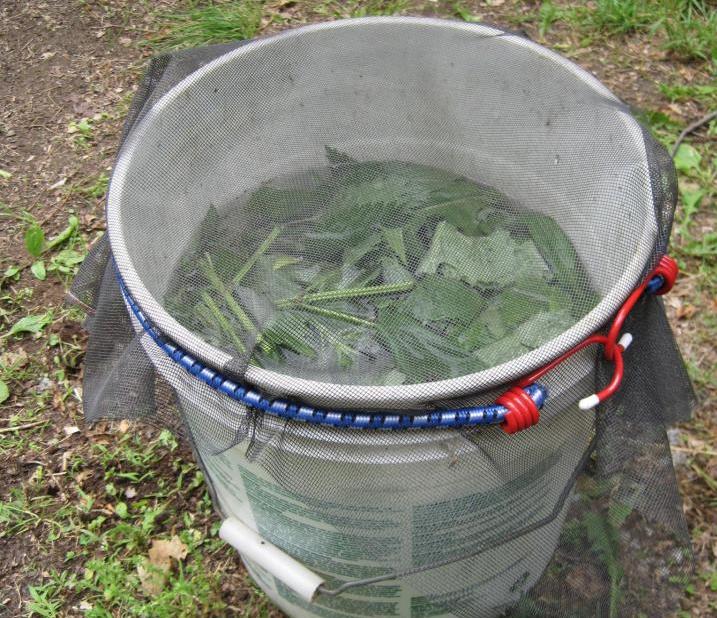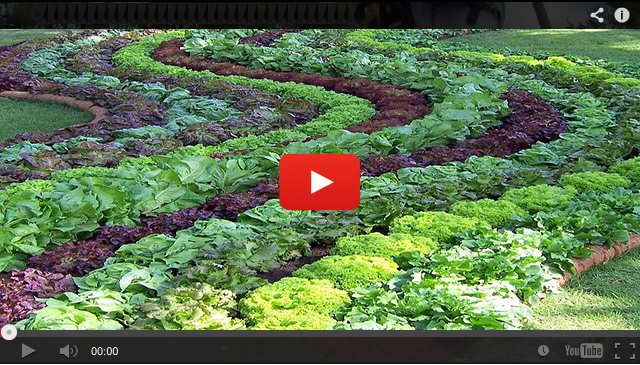You can make your own all-purpose, organic plant fertilizer at home—with just weeds and water. Does it sound strange to make plant fertilizer by using other plants? That’s how nature works! Here’s my simple recipe for DIY organic fertilizer—without using chemicals or animal waste—right from your garden!
Forget chemical concoctions! An abundant source of nutritious plant food is already available, for free, in your garden. Common garden plants and even unwanted weeds hold vitamins and nutrients in their leaves that, when decomposed, can be a quick source of macro- and micronutrients to feed your garden.
Using plants to feed plants is not that different than the process to make compost, albeit at a slower rate. Quick-growing annual flowers and food crops sometimes need nutrients faster than they can be released from the soil or the compost that you apply in the spring.
Moreover, no matter how “complete” your potting mix may be, containers do not hold an endless supply of nutrients, some of which also wash out through drainage holes. Supplemental feeding with solid or liquid plant-based feed is a swift and efficient way to apply the most-needed nutrients directly to the roots or leaves of fast-growing plants at the exact time that they need it.
This homemade fertilizer is no joke. The theory is that weeds are super adept at extract nutrients where other plants cannot. We can then ferment these leaves to make super-charged organic liquid fertilizer that will blow the socks off of anything commercially available…all for free!
The fermented concentrate is then diluted to a 1:3 ratio for conventional watering and 1:9 for foliar feeding. Unreal results, give it a try!
If you’re just starting out gardening in 2022, making your own food can get you and your veggies up and running this spring! I know there is a fevered and renewed interest in gardening and many of you are seasoned vets. But remember that there’s a whole population out there that hasn’t gardened before.
Feed Your Garden With This Organic Fertilizer Tea—for Free!
Feed your plants—with your own plants! Using your own garden weeds and grass, you can make homemade fertilizer tea that’s 100% organic! It’s a great boost for your plants in midsummer when they run low on soil fertility. Here’s how to make fertilizer tea at home.
Yes, garden plants appreciate a spot of tea now and then, too—just like I do—as a pick-me-up. No expensive Earl Grey or Darjeeling for them, though. Instead, I make a free fertilizer tea from plants, weeds, and grasses that I find on my property.
What Is Fertilizer Tea?
“Compost tea” and “manure tea” have been mainstays of the organic garden for a long time. It is not hard to toss some compost into a bucket of water and let it steep for a few days to a few weeks, stirring daily.
“Fertilizer teas” made from plants are just as easy. Plus, they don’t require you to pick up a load of manure or use any of your precious compost.
Making Fertilizer Tea
Next time you are weeding the garden, throw chopped weeds into a bucket or trash can, chopping them up as you go.
When the container is about half full, fill it with water. Don’t use chlorinated water; rainwater is the best (also free!).
Screen the top to keep mosquitoes out. You can use a piece of screening or row cover.
Stir daily for 3 days to 2 weeks. Or, pour it from one bucket into another to mix things up and keep it aerated.
Strain off the liquid to use as a fertilizer or foliar spray. After you strain off the liquid, return the solids to your compost pile. It can be diluted or used full strength on established plants. Since plant leaves tend to absorb more nutrients more quickly than roots, foliar feeding is an efficient way to fertilize versus a soil drench.
Weeds are full of nutrients they have absorbed from your soil, so it is only fitting to extract the water soluble ones and return them to your garden plants.
Weeds and plants to chop up for an extra nourishing fertilizer tea:
Stinging nettle is high in nitrogen, calcium, iron, vitamins A, B, & C, phosphorus, potassium, boron, iron, zinc, selenium, and magnesium. A natural insect repellant, when sprayed on leaves it can help plants resist insect and fungal attacks. Learn more about stinging nettle’s many benefits.
Alfalfa is high in nitrogen, vitamin A, folic acid, potassium, calcium, and trace minerals. If you don’t have access to it, you can use alfalfa hay, meal, or pellets. This is a “weed” whose growth I encourage in my garden, along with clover. Both are legumes and make a great soil-enhancing mulch or nitrogen-rich tea.
Horsetail is a deeply rooted weed that draws up minerals including potassium, silica, and iron from far below the soil.
Willow is rich in growth hormones, making it especially good for getting young transplants off to a good start.
Comfrey is rich in calcium, phosphorus, potassium, magnesium, vitamins A, B, & C, and trace minerals.
Chicory is high in potassium, calcium, and vitamin A.
Dandelions can be put to good use making a tea that is full of vitamins A & C, as well as with calcium and potassium.
Don’t have any of those plants? Plain old grass works well too. Fresh grass clippings are high in nitrogen and potassium. Gather up your clippings next time you mow the lawn, fill a bucket 2/3 full of them, add water and steep 3 days, stirring daily.
Fertilizer teas are fast-acting and free. Apply them no more than every two weeks or when your plants need a boost. They are especially effective on newly transplanted ones and those in blossom or setting fruit. Brew up a batch of weeds and throw a garden tea party for your plants!
Making Your Own Organic Fertilizer
If you wish to try your hand at making fertilizer, there’s more than one way to go about it.
The simplest method is to brew herbs and weeds—much as you would a morning tea. My favorite herbs to try are:
- Comfrey – High in magnesium, phosphorous, and potassium.
- Stinging Nettle – Contains magnesium, sulphur, and iron.
- And also, Horsetail– Loaded with silica, a nutrient that makes plants strong.
Borage and chickweed are also abundant and nutritious. They’re slightly less nutrient-dense, but even dried kitchen herbs such as chamomile, oregano, sage, and dill that have become old and unpalatable can be used up in this way, too.
I. Simple Weed Fertilizer Recipe
- Stuff a bucket about half-full with roughly chopped leaves, stems, and flowers of weeds or pruned herbs. Pack them in tightly.
- Fill with water. You can use tap water or water from a rain barrel or speed the process by using heated, but not boiling, water.
- Set aside to steep for a day in the sun. Cover with fine mesh to prevent mosquitoes from laying eggs.
- Strain out the herbs or weeds and fill up a spray bottle (or watering can) with the concoction.
- Pour it on the soil or fill a spray bottle to spray the leaves of your plants as a foliar feed.
The potency of fertilizer teas improves as the plants decompose. The best teas are steeped for days or even weeks. However, the high nitrogen content in some plants, such as comfrey and stinging nettle, eventually creates a slop that stinks something fierce! Save the most malodorous brews for outdoor use; apply mixes that have been brewed for no longer than a day or so to houseplants and seedlings grown indoors.

Photo: Robin Sweetser
II. An Even Better Brew: Add Aeration
To make an even better brew, add an aquarium bubbler to your bucket as it steeps. Aeration during the brewing process helps to maintain a healthy, oxygenated “tea” that is full of helpful bacteria and microorganisms. It smells better, too.
- Stirring or agitating the mix by hand multiple times a day will achieve a similar effect, but a pump will do the work for you.
- Dilute your finished fertilizer with water until it looks like weak tea. Then pour on the soil or fill a spray bottle to use as a foliar feed.
Apply in the early morning when the sun is less intense and dilute by half again if you notice any signs of leaf burning.
In this video, we explain the basics of plant nutrition, how this differs from plant to plant, and what to look for when buying commercial feed. We demonstrate how to make your own fertilizer and show you how to use wood ash and grass cuttings to boost soil health.
III. Buying an Organic Fertilizer
If you’re reading this and the DIY route isn’t for you (perhaps you don’t have the herbs), then we can recommend a great organic fertilizer—our own!
As of 2022, The Old Farmer’s Almanac makes an organic plant fertilizer to deliver protein-based nutrition to your tomatoes, vegetables, and herbs, including both slow- and quick-release nutrients. It works with your soil’s ecosystem and contains no chemicals, manure, or the associated harsh odors. Learn more about: HOW TO START A HIGH-PERFORMANCE HOMESTEAD
Books can be your best pre-collapse investment.
Carnivore’s Bible (is a wellknown meat processor providing custom meat processing services locally andacross the state of Montana and more. Whether your needs are for domestic meator wild game meat processing)
The Lost Book of Remedies PDF ( contains a series of medicinal andherbal recipes to make home made remedies from medicinal plants and herbs.Chromic diseases and maladies can be overcome by taking the remediesoutlined in this book. The writer claims that his grandfather was taughtherbalism and healing whilst in active service during world war twoand that he has treated many soldiers with his home made cures. )
Easy Cellar(Info about building and managing your root cellar, plus printable plans. The book on building and using root cellars – The Complete Root Cellar Book.)
The Lost Ways (Learn the long forgotten secrets that helped our forefathers survive famines,wars,economic crisis and anything else life threw at them)
LOST WAYS 2 ( Wordof the day: Prepare! And do it the old fashion way, like our fore-fathers did it and succeed longbefore us,because what lies ahead of us will require all the help we can get. Watch this video and learn the 3 skills that ensured our ancestors survival in hard times offamine and war.)




